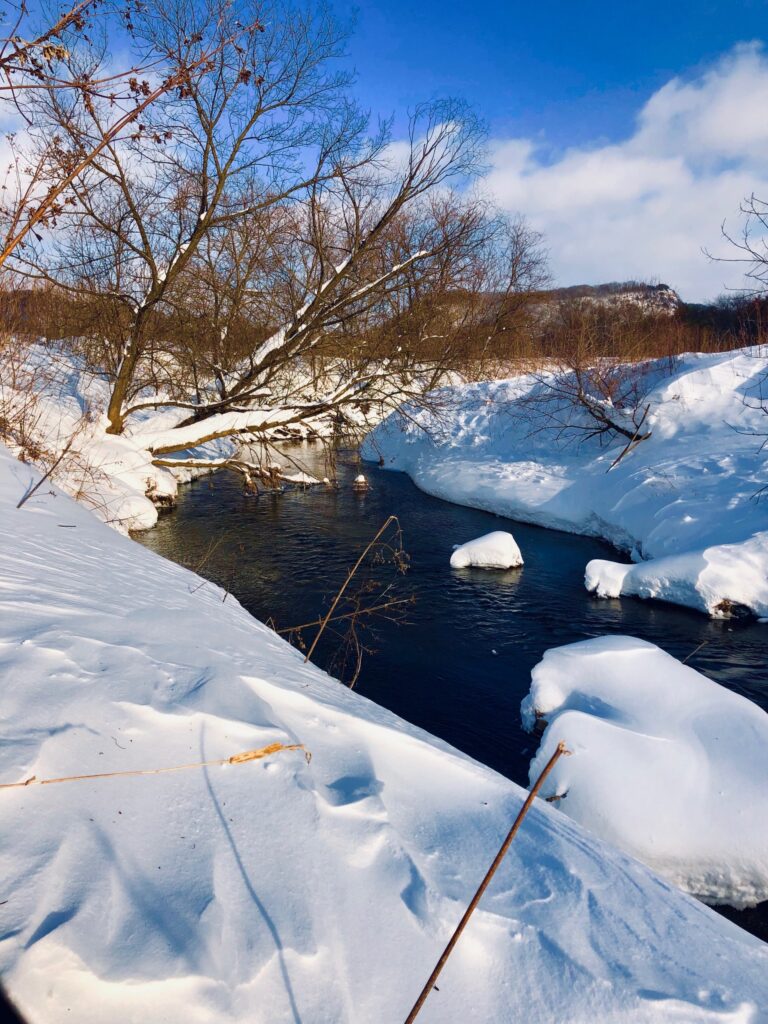Winter Habitat Preferences of Trout in the Driftless Area
By Dr. Jennifer Biederman

The Driftless Area, spanning parts of Minnesota, Wisconsin, Iowa, and Illinois, is renowned for its spring-fed streams, cold water, and limestone geology. These unique environmental factors create ideal year-round conditions for trout. In streams with the most groundwater influence, both flows and water temperatures remain fairly constant throughout the year. Winter water temperatures don’t vary significantly from summer water temperatures, as they are constantly buffered from springs that maintain a constant temperature that reflects approximately the mean annual air temperature. These conditions, along with aquatic macroinvertebrate populations that, even though may be reduced in the winter, are still highly productive – especially with winter emerging midges – mean that trout actively feed and even grow throughout much of the colder times of year. That also means that winter is a really great time to fish Driftless streams!
During winter, trout can show some behavioral adaptations to survive where conditions are harsher in less groundwater-fed streams where winter temperatures may approach stressful thresholds. In this case, trout can become less active, conserving energy in slower water habitats. Feeding becomes sporadic, with trout relying primarily on small invertebrates drifting in the current. Additionally, trout often congregate in deeper pools, where they benefit from reduced energy expenditure and mutual protection.
Keep reading to learn about where you might find trout lurking during winter.
Deep Pools
Deep pools are an important winter refuge for trout. These areas provide slower water currents, allowing trout to conserve energy during a time when food resources may be a bit less available and offer protection from predators, including hawks, eagles, and blue herons that stick out the cold near open water. The best pools are those that also have some overhead cover, including undercut banks, fallen trees, or boulders, which provide additional shelter and security.
Fishing Tip: Target deep pools with slow-moving presentations, such as nymphs or small jigs. Trout are less likely to chase fast-moving lures in winter, so a slow, deliberate approach works best.
Groundwater Inflows and Springs
Groundwater plays a really important role in sustaining trout populations during winter. Groundwater inputs help moderate water temperatures, preventing freezing and maintaining dissolved oxygen levels. Areas with noticeable spring seeps or upwelling groundwater serve as thermal refuges, where trout can find stable conditions amid otherwise harsh environmental changes.
Fishing Tip: Look for areas where warmer groundwater enters the stream. These spots often attract trout seeking stable temperatures and better oxygen levels.
Stable, Well-Oxygenated Water
Trout require stable, oxygen-rich water throughout winter. Reduced streamflow and ice cover can limit oxygen exchange, posing a threat to trout survival. Areas with gentle, consistent currents, such as riffles, help maintain adequate oxygen levels. Without sufficient oxygen, trout become vulnerable to stress, disease, and increased mortality.
Fishing Tip: Focus on tailouts of riffles where oxygen levels remain higher and food can drift naturally downstream. Drift nymphs or small streamers through these areas.
Overhead Cover
Overhead cover is another essential component of winter trout habitat. Structures such as undercut banks, submerged wood, root wads, and overhanging vegetation provide protection from predators, particularly avian species like herons and eagles. Cover also reduces light exposure, creating a more secure and energy-efficient environment for trout.
Fishing Tip: Be a bit sneaky when approaching areas with overhead cover. Trout in these spots are cautious, and excessive movement or noise can easily spook them.
Slow Currents Adjacent to Faster Water
Trout favor low-energy environments in winter but still require access to faster currents that deliver drifting food. Ideal habitats include pool tailouts, eddies, and inside bends of streams, where trout can remain relatively inactive while still accessing occasional food sources.
Fishing Tip: Present your bait or fly naturally in slow-moving eddies or near the seams of faster water. Small midge or mayfly patterns are often effective.
